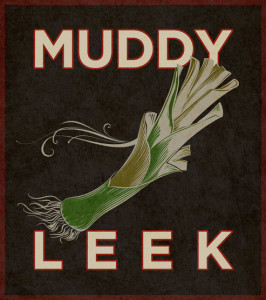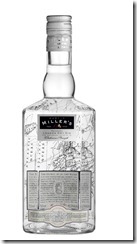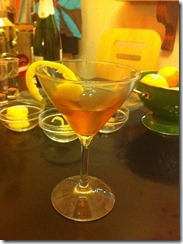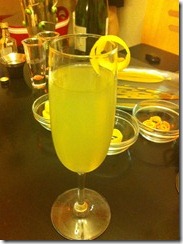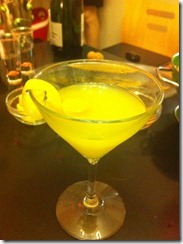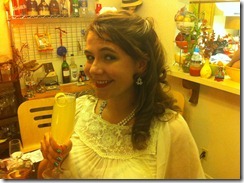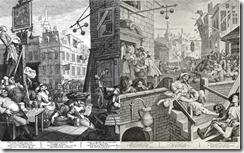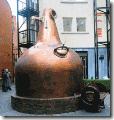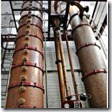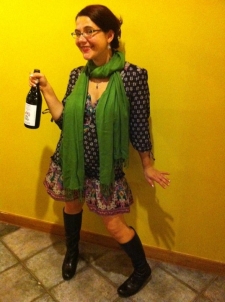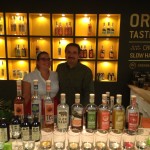 I first experienced GreenBar Spirits upon starting my new job as Beverage Director at The Muddy Leek in Los Angeles. My 1st week was all about trying to figure out what my predecessor had left for me and where to go from there. I noticed we were running low on our house rum, and before placing an order to restock I decided to try the stuff on our “reserve shelf”. I saw there was a rum called Carusoe. It caught my eye for three reasons: 1. It is organic, and so is our restaurant, 2. It is produced locally, and we are a farm to table concept, & 3. As an ex-Miami girl it reminded me of David Caruso from CSI Miami, and I am a lady that LOVES a bad crime show. And then I tasted it and I was blown away. As an ex-Floridian I pretty much grew up on rum, but this was so smooth, aromatic, and inviting!!!! I was hooked and had to know more about this Greenbar Distillery.
I first experienced GreenBar Spirits upon starting my new job as Beverage Director at The Muddy Leek in Los Angeles. My 1st week was all about trying to figure out what my predecessor had left for me and where to go from there. I noticed we were running low on our house rum, and before placing an order to restock I decided to try the stuff on our “reserve shelf”. I saw there was a rum called Carusoe. It caught my eye for three reasons: 1. It is organic, and so is our restaurant, 2. It is produced locally, and we are a farm to table concept, & 3. As an ex-Miami girl it reminded me of David Caruso from CSI Miami, and I am a lady that LOVES a bad crime show. And then I tasted it and I was blown away. As an ex-Floridian I pretty much grew up on rum, but this was so smooth, aromatic, and inviting!!!! I was hooked and had to know more about this Greenbar Distillery.
Recently Dave and I had the privilege of touring the Greenbar Distillery in Downtown Los Angeles. We were guided by the 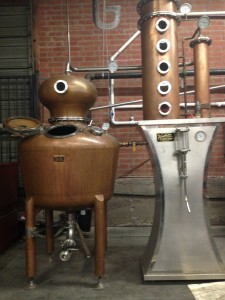 very charismatic Melkon Khosrovian, Co-Owner of this Willy Wonka Factory for Adults. Upon arriving I was hit with the most amazing waft of citrus, only to later find out they had just been hand zesting tons of local organic oranges to be used in their Fruitlab Orange Liqueur. Melkon first took us to his stills. They have one classic Pot Still which up to this point has been churning out the bulk of their production, and they just acquired a Continuous Fractionating Column Still, which will allow them to have much more control over the finished product so that they can fully actualize the flavors they have steeping in their brains. The rest of this area is full of about twelve stainless steel, temperature controlled fermentation vats, similar to the ones that are used in wine production…. this is where all of the flavor magic happens. I felt like a kid in a candy store.
very charismatic Melkon Khosrovian, Co-Owner of this Willy Wonka Factory for Adults. Upon arriving I was hit with the most amazing waft of citrus, only to later find out they had just been hand zesting tons of local organic oranges to be used in their Fruitlab Orange Liqueur. Melkon first took us to his stills. They have one classic Pot Still which up to this point has been churning out the bulk of their production, and they just acquired a Continuous Fractionating Column Still, which will allow them to have much more control over the finished product so that they can fully actualize the flavors they have steeping in their brains. The rest of this area is full of about twelve stainless steel, temperature controlled fermentation vats, similar to the ones that are used in wine production…. this is where all of the flavor magic happens. I felt like a kid in a candy store.
We chatted about how Greenbar came to be, and why he uses only local and organic fruits and botanicals. It turns out it all happened quite “organically”. There was not that Eureka moment where he and his wife woke up and said, today we are diving head first in to the spirits industry. It all started with a need for flavor. Basically he began infusing base spirits to create something that would satisfy his wife’s discriminating palate. The couple soon became so good at creating tasty brews they could hardly keep up with the growing demand of their friends and family. And soon a company was born. The organic happened next and was also born purely out of a need for flavor. They had ordered a batch of celery and noticed that it was greener and more aromatic than the rest of the celery they had used. They were thrown for a loop. It totally changed their product. They went back to the farmer to inquire where this super celery came from, and he explained that in order to save their land they had gone organic. Suddenly a light bulb went on. They soon began using all organic produce, and sure enough their product was better and more consistent than it had ever been. This concept soon snowballed for them, and Greenbar was born. Now they are so green, that every time you have a cocktail made with Greenbar products you actually reduce your carbon footprint by one day. So another great reason to stop by Muddy Leek, you can have one of my Greenbar based cocktails and feel better about yourself by saving the world the tastiest way possible. You may be trying to figure out this carbon footprint math so I will break it down for you. They work with all certified organic ingredients, which helps keep the farmland, the water and the consumers free of artificial fertilizers, synthetic pesticides, and GMOs. And as someone who just spend some time in the Rio Grande Valley of TX, where the water is so laden with pesticides it is undrinkable, I can not stress the importance of organic farming practices. They also use lightweight bottles, which uses less fuel to transport. They use 100% PCW recycled labels, and avoid using frosting or metallic paints which cause pollution. And my favorite thing is they plant one tree in Central American rain forests for every bottle sold. This is not only to replenish the forests, but also to provide shade for coffee and cocoa farmers to grow better products, and support their family. So the equation is One person makes 121 lbs of CO2 daily + Greenbar cocktail is -137 lbs CO2= -16 lbs CO2. So when you drink GreenBar products, we all win!
his wife’s discriminating palate. The couple soon became so good at creating tasty brews they could hardly keep up with the growing demand of their friends and family. And soon a company was born. The organic happened next and was also born purely out of a need for flavor. They had ordered a batch of celery and noticed that it was greener and more aromatic than the rest of the celery they had used. They were thrown for a loop. It totally changed their product. They went back to the farmer to inquire where this super celery came from, and he explained that in order to save their land they had gone organic. Suddenly a light bulb went on. They soon began using all organic produce, and sure enough their product was better and more consistent than it had ever been. This concept soon snowballed for them, and Greenbar was born. Now they are so green, that every time you have a cocktail made with Greenbar products you actually reduce your carbon footprint by one day. So another great reason to stop by Muddy Leek, you can have one of my Greenbar based cocktails and feel better about yourself by saving the world the tastiest way possible. You may be trying to figure out this carbon footprint math so I will break it down for you. They work with all certified organic ingredients, which helps keep the farmland, the water and the consumers free of artificial fertilizers, synthetic pesticides, and GMOs. And as someone who just spend some time in the Rio Grande Valley of TX, where the water is so laden with pesticides it is undrinkable, I can not stress the importance of organic farming practices. They also use lightweight bottles, which uses less fuel to transport. They use 100% PCW recycled labels, and avoid using frosting or metallic paints which cause pollution. And my favorite thing is they plant one tree in Central American rain forests for every bottle sold. This is not only to replenish the forests, but also to provide shade for coffee and cocoa farmers to grow better products, and support their family. So the equation is One person makes 121 lbs of CO2 daily + Greenbar cocktail is -137 lbs CO2= -16 lbs CO2. So when you drink GreenBar products, we all win!
Melkon then brought us to the tasting room, which is my favorite part! He first mixed up a delightful Ixa tequila, lime, and 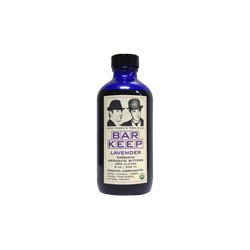 poppy tequila concoction. (Ixa is the only product not made on premises. It has to be made in Mexico, because it is much less green to uproot the Agave and truck it CA, and there is a good chance it would rot on the way, so Melkon makes an annual trip to Mexico to whip up this tasty Tequila.) We chatted about how when thinking of new products he is constantly chatting with bartenders and mixologists to come up with things that make the industry better and easier for us. He also explained his Bar Keep bitters program, where he actually holds an annual competition for bartenders across the country to submit their own bitters recipes, and whichever one wins gets added to the line, with the bartender getting a cut of each bottle sold — He may be seeing a Sara Kay submission next year 😉 So far there are: Apple, from Marshall Altier in New York, NY; Chinese, from Josh Loving in Austen TX; Fennel, from Adam Stemmler & Dustin Haarstad in San Diego, CA; and Lavender, from Tobin Eliis & John Hogan in Las Vegas NV & Baltimore MD.
poppy tequila concoction. (Ixa is the only product not made on premises. It has to be made in Mexico, because it is much less green to uproot the Agave and truck it CA, and there is a good chance it would rot on the way, so Melkon makes an annual trip to Mexico to whip up this tasty Tequila.) We chatted about how when thinking of new products he is constantly chatting with bartenders and mixologists to come up with things that make the industry better and easier for us. He also explained his Bar Keep bitters program, where he actually holds an annual competition for bartenders across the country to submit their own bitters recipes, and whichever one wins gets added to the line, with the bartender getting a cut of each bottle sold — He may be seeing a Sara Kay submission next year 😉 So far there are: Apple, from Marshall Altier in New York, NY; Chinese, from Josh Loving in Austen TX; Fennel, from Adam Stemmler & Dustin Haarstad in San Diego, CA; and Lavender, from Tobin Eliis & John Hogan in Las Vegas NV & Baltimore MD.
We then got down to the business of tasting the full line, and some specialty projects, like his truffle vodka that Melkon made for a 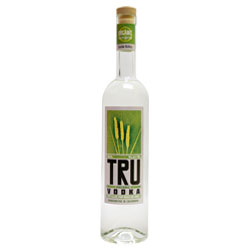 spirits dinner early on in his journey. That is one expensive shot for a discriminating palate ;). We tasted through the entire line of TRU vodkas: Straight, Lemon, Garden, and Vanilla. I appreciated that the infusions where not heavy-handed and did not taste synthetic, because they are not.There are tons of tasty cocktails that can be borne of these, and they were also highly enjoyable on their own, especially the garden, it reminded me of a less aggressive gin.
spirits dinner early on in his journey. That is one expensive shot for a discriminating palate ;). We tasted through the entire line of TRU vodkas: Straight, Lemon, Garden, and Vanilla. I appreciated that the infusions where not heavy-handed and did not taste synthetic, because they are not.There are tons of tasty cocktails that can be borne of these, and they were also highly enjoyable on their own, especially the garden, it reminded me of a less aggressive gin.
Speaking of Gin, our next stop was Tru Gin which has a honeyed color because they choose to make it in the fashion of the 16th century by macerating the botanicals in alcohol. They refer to it as Renaissance Gin, and it definitely offers a depth of flavor and is richer than most modern gins on the market. Their chosen botanical bunch is: Juniper, lemon, lavender, angelica, orris, coriander, vanilla, cardamom, clove, fennel, cinnamon, allspice, chamomile, & star anise…. and love.
We tasted the IXÁ Organic Tequila on its own, and it erased all feelings of tequila I had stored up from a miss-sipped 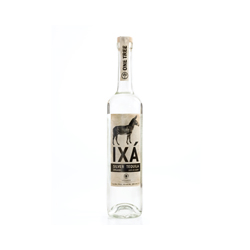 youth. And by miss-sipped I mean shots of rot gut te-kill-ya. This tequila is made with 100% organic blue heartland agave. This is a creamy tequila, with notes of thyme and clay. It is a fantastic sipper, and would be a great base for herbal cocktails. Melkon explained this was such a smooth sipper because they start with organic mature agave, which is sweeter and more flavorful. They quarter and steam the cactii in clay ovens for three days to caramelize the sugars, and then press the cooked agave and ferment the juice with a high ratio of agave fiber, and white wine yeast for a fuller flavor. They then double distill it in an alembic pot still to taste, in super small batches. This deviates from the te-kill-ya production in that most large modern producers harvest young agave, then pressure cook it in stainless steel, they also only ferment the agave juice so you are not getting the richness from the fibers, and then they distill to maximum output.
youth. And by miss-sipped I mean shots of rot gut te-kill-ya. This tequila is made with 100% organic blue heartland agave. This is a creamy tequila, with notes of thyme and clay. It is a fantastic sipper, and would be a great base for herbal cocktails. Melkon explained this was such a smooth sipper because they start with organic mature agave, which is sweeter and more flavorful. They quarter and steam the cactii in clay ovens for three days to caramelize the sugars, and then press the cooked agave and ferment the juice with a high ratio of agave fiber, and white wine yeast for a fuller flavor. They then double distill it in an alembic pot still to taste, in super small batches. This deviates from the te-kill-ya production in that most large modern producers harvest young agave, then pressure cook it in stainless steel, they also only ferment the agave juice so you are not getting the richness from the fibers, and then they distill to maximum output.
We moved on to Slow Hand Organic Whiskey which is a white whiskey. It will confuse your average whiskey sipper, as it 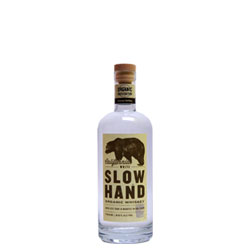 in not aged in charred oak, and glowing with hints of amber, and sweet nuttiness. Most aged whiskeys are made to highlight the distillers use of oak and blending, this one on the other hand is meant to highlight the grains (organic oats, barley, & spelt) to be exact), and that it does. It smells like cream and oats, and the barley gives it a nice nuttiness in the mid pallet. This is a great sipping whiskey, and would also be fun in a whiskey flight as a starter.
in not aged in charred oak, and glowing with hints of amber, and sweet nuttiness. Most aged whiskeys are made to highlight the distillers use of oak and blending, this one on the other hand is meant to highlight the grains (organic oats, barley, & spelt) to be exact), and that it does. It smells like cream and oats, and the barley gives it a nice nuttiness in the mid pallet. This is a great sipping whiskey, and would also be fun in a whiskey flight as a starter.
Crusoe Organic Rum (both silver and spiced) were up to bat next. I am familiar with the silver as it is the base of my cocktail the Celia at the Muddy Leek. I was originally drawn to this rum because it has more body and layers then most silver rums and is not overly sweet. It turns out this line was inspired by Robinson Crusoe, and they combine Caribbean-style molasses, with California style fermentation. For both rums they ferment molasses in temperature controlled tanks, with white wine yeast. Extended fermentation, and double distillation 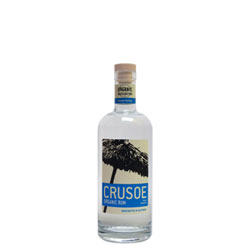 allows for fuller richer flavors. At this point their production varies a bit. For the Silver they use micro oxygenation, a technique common in the wine industry, they do this in place of oak aging the rum, which can strip it of some of its natural notes. For the Spiced they macerated whole cinnamon, clove, nutmeg, allspice, vanilla, orange zest, Osmanthus flower, and molasses over a 3-4 week period, since they are dealing with whole ingredients, no two batches behave the same, so they taste each batch daily and add or subtract from the maceration until it reaches the desired symphony of flavors. Both of these rums make me think twice about dumping in a bunch of sugar and crushed mint.
allows for fuller richer flavors. At this point their production varies a bit. For the Silver they use micro oxygenation, a technique common in the wine industry, they do this in place of oak aging the rum, which can strip it of some of its natural notes. For the Spiced they macerated whole cinnamon, clove, nutmeg, allspice, vanilla, orange zest, Osmanthus flower, and molasses over a 3-4 week period, since they are dealing with whole ingredients, no two batches behave the same, so they taste each batch daily and add or subtract from the maceration until it reaches the desired symphony of flavors. Both of these rums make me think twice about dumping in a bunch of sugar and crushed mint.
We ended the evening exploring the Fruitlab Organic Liqueurs. I was already familiar with the Grand Poppy which is a California inspired take on classic European aperitives. I used it as the mid-pallet note in my Celia cocktail, along with the Crusoe Silver Rum. It is bitter-sweet and honeyed. It is a blend of California poppy, orange, lemon, grapefruit, bearberry, California bay leaf, pink peppercorn, 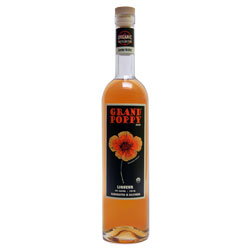 dandelion, blessed thistle, burdock rue, artichoke, gentian, geranium, cherry bark, and cane sugar. And it shows. There is also Ginger, Hibiscus, Jasmine, & Orange. They are all amazing, and a mixologist’s friend, as they have a huge depth of flavor without being syrupy sweet.
dandelion, blessed thistle, burdock rue, artichoke, gentian, geranium, cherry bark, and cane sugar. And it shows. There is also Ginger, Hibiscus, Jasmine, & Orange. They are all amazing, and a mixologist’s friend, as they have a huge depth of flavor without being syrupy sweet.
It was such a treat to meet Melkon and taste his full portfolio. I know I will be proudly using GreenBar in any beverage programs I design, and I encourage all of you to as well… for your home bars. Not only are all of the products truly tasty, but they are all local, organic, & sustainable! And the more we as a market demand this, the more it will become available.
Cheers to GreenBar!
As a Parting tidbit I will share my Celia recipe. I encourage you to try this at home!!! But if you are near Culver City then you can just stop in to The Muddy Leek (8631 Washington Blvd, Culver City, CA 90232) and I’ll mix one up for you.
- 2 oz Crusoe Rum
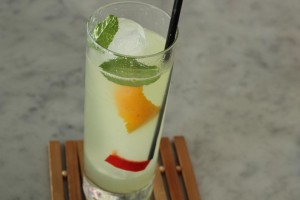
- ½ Grand Poppy
- 1 oz Lime
- ½ Spicy cucumber syrup
- ½ Simple syrup
- 6 drops of Orange Blossom Water
- Drop in a pickled sweet pepper, orange zest & mint in a Collins Glass with an Ice Spear
- Shake & Strain Drink Mixture into The Collins Glass
- Top with Club Soda
If you would like to contact GreenBar for more info, or check out more tasty recipes here is how:
GreenBar Collective 2459 E 8th St, Los Angeles, CA 90021(213) 375-3668

